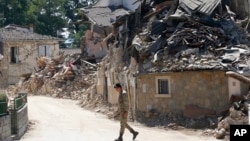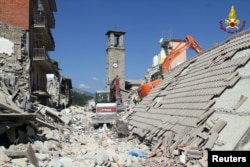Italian officials have opened an investigation to focus on different structures that collapsed after Wednesday’s powerful quake, devastating four towns in the mountainous heartland of the country and rattling the central agricultural regions.
Regional public prosecutors say they will not only investigate why recently constructed public buildings, including a schoolhouse renovated in 2012, failed to withstand the quake’s force, but they are threatening also to file charges against private-property owners who may have altered their houses — most very ancient — in ways that breached current building codes and anti-seismic engineering regulations.
"Everyone suspects such a tragedy was not just a question of destiny," said the chief prosecutor of the province of Rieti, Giuseppe Saieva,
"Our duty is to verify if there was also responsibility, human culpability," he added.
Italy marked a day of national mourning Saturday for the nearly 300 people confirmed killed.
Criminal charges for illegal renovations
The prosecutors’ threats are enraging survivors and relatives of the dead. Residents stress that renovation work seldom observes the country’s notoriously complex building regulations, which more often than not are bypassed by homeowners with a bribe or a fine agreed with their local commune (town) officials.
“Our houses are hundreds of years [old] and it is impossible or prohibitively expensive to make changes within the regulations that are drawn up by the government in Rome without any regard to our economic circumstances,” said Perluigi, a retiree from Amatrice, the worst-hit of four towns devastated by the midweek quake. He asked for his full name to be withheld as he had recently renovated his property.
Saieva appears to have little sympathy for traditional arguments about building codes and complaints about the byzantine, slow-moving bureaucracies that ordinary homeowners have to battle to get anything done. He says he intends to mount a house-by-house investigation and is prepared to file criminal charges against anyone - even those who lost family members - if their renovations failed to observe anti-seismic regulations.
“If you moved a partition, you risk being charged with manslaughter,” he argued. Saieva added: "There is the responsibility of nature and seismic activity and then there is the responsibility of individuals.” The prosecutor says he’s considering ordering police to mount a round-the-clock guard on the rubble of Amatrice’s municipal buildings to ensure documents and computer hard drives that survived the quake aren’t removed.
The renovation work on the town’s elementary schoolhouse four years ago was undertaken by brothers who have been accused in the past of association with the mafia.
More burials for town in mourning
As the prosecutor issued his threats, nine more bodies were dug out Saturday by emergency crews from the rubble of Amatrice, which so far has accounted for 230 of those killed midweek. Earlier Saturday, Italian President Sergio Mattarella toured the mainly medieval hilltop stone town to see the damage for himself before traveling to Ascoli Piceno for a funeral service held in a sports hall where 35 wooden coffins were lined up.
On the top of the coffins were flowers and photographs of those who lost their lives. The dead being honored at Ascoli Piceno came from Arquata del Tronto, another one of the towns devastated by Wednesday’s magnitued 6.2 quake.
Two of the caskets contained the remains of two children - 18-month-old Marisol Piermarini and nine-year-old Giulia Rinaldo, whose younger sister survived and was found by a rescue crew holding her dead sibling.
Italian Prime Minister Matteo Renzi repeated his promise at the funeral service to rebuild the shattered communities, but the mayor of Amatrice urged the government to not only rebuild but also not to repeat the snail-pace post-quake reconstructions of recent years.
Renovation work on the city of L’Aquila, which was severely damaged in a 2009 quake, still remains incomplete and more than 8,000 of the city’s inhabitants are still housed in temporary accommodation.
“What we need is a reconstruction in record time. It is a great opportunity for politicians to show extraordinary commitment," Mayor Sergio Pirozzi told President Mattarella.
Mourners who packed the sweltering sports hall included many injured from the earthquake. They wept and embraced each other as Ascoli Piceno’s bishop, Giovanni D’Ercole, told them: “Don't be afraid to cry out your suffering — I have seen a lot of this — but please do not lose courage.”
The prelate also urged the government to rebuild the towns of Amatrice, Arquata, Accumoli and Pescara del Tronto, saying, “Only together can we rebuild our houses and our churches. Together, above all, we will be able to restore life to our communities.”
As the bishop spoke, many of the relatives of the dead cried quietly. One woman consoled her husband by rubbing his back gently as he bowed his head. Among the mourners were doctors and nurses who had treated the injured.
Reforms urged for quake-prone Italy
Outside the packed sports hall, hundreds of locals came to pay their respects. “Even if I didn't know them my heart broke for them. My thoughts are with them because there are people who have lost everything, homes, loved ones,” local resident, Luciana Cavicchiuni, told reporters.
She added: “These things should not happen.”
But civil protection experts and geologists say Italy is likely to experience many more high death tolls and quake devastation in the future.
In an interview with Rome’s Il Messaggero newspaper, Fabrizio Curcio, an engineer and head of the Dipartimento della Protezione Civile, warned that earthquakes in Italy, which is built on two major seismic fault-lines, have become a regular fixture and that the time between big temblors hitting is reducing all the time.
He argues that Italians need to rethink what they expect from the government in terms of rebuilding damaged towns and homes. Currently the vast majority of Italians do not take out insurance on their homes — let alone earthquake insurance. Many private-sector insurers don’t even offer quake insurance, even if a homeowner requests it.
This needs to change, says Curcio, who thinks Italians need to be willing to have their homes assessed by insurers from a seismic point of view. “I believe this is the model to aim for, even, to limit the burden on the State,” he maintains.
But it will be difficult for politicians to engineer such a change and to persuade already straitened households, especially in deeply depressed and neglected rural areas where unemployment is sky high and economic prospects remain grim, to accept the cost of private insurance.
In Pictures: Italy Earthquake Aftermath










